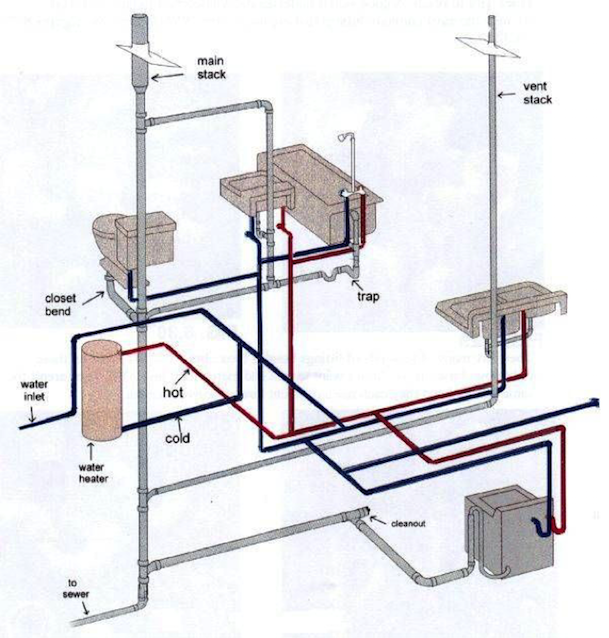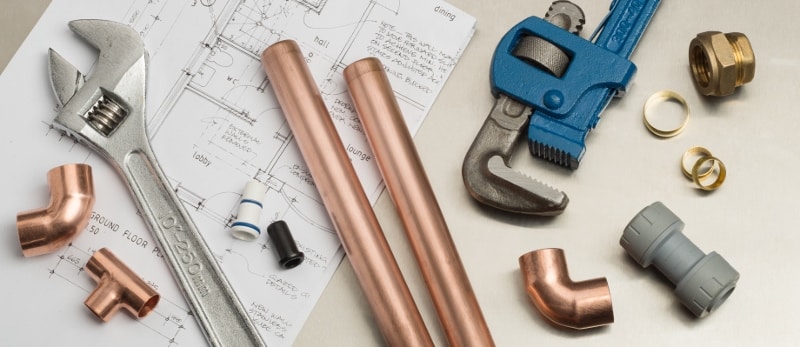They are making a few good points related to The Inner Workings of Your Home's Plumbing overall in the article following next.

Comprehending just how your home's plumbing system works is crucial for each home owner. From delivering clean water for alcohol consumption, food preparation, and showering to safely eliminating wastewater, a properly maintained plumbing system is important for your family members's wellness and convenience. In this extensive guide, we'll check out the complex network that composes your home's plumbing and offer ideas on upkeep, upgrades, and handling common problems.
Intro
Your home's plumbing system is greater than simply a network of pipelines; it's a complex system that ensures you have access to tidy water and reliable wastewater elimination. Recognizing its parts and how they interact can aid you prevent expensive repair services and make sure whatever runs smoothly.
Basic Parts of a Plumbing System
Pipes and Tubes
At the heart of your pipes system are the pipelines and tubes that lug water throughout your home. These can be constructed from numerous materials such as copper, PVC, or PEX, each with its advantages in terms of resilience and cost-effectiveness.
Fixtures: Sinks, Toilets, Showers, and so on.
Components like sinks, commodes, showers, and bath tubs are where water is made use of in your house. Comprehending how these fixtures link to the pipes system aids in identifying problems and intending upgrades.
Shutoffs and Shut-off Points
Valves regulate the flow of water in your pipes system. Shut-off shutoffs are important during emergencies or when you require to make fixings, permitting you to isolate parts of the system without interrupting water flow to the whole home.
Water Supply System
Key Water Line
The main water line attaches your home to the local water or an exclusive well. It's where water enters your home and is dispersed to various fixtures.
Water Meter and Stress Regulator
The water meter steps your water usage, while a stress regulatory authority makes sure that water streams at a safe pressure throughout your home's pipes system, stopping damage to pipes and components.
Cold Water vs. Warm water Lines
Comprehending the difference in between cold water lines, which supply water directly from the major, and hot water lines, which lug warmed water from the water heater, aids in repairing and planning for upgrades.
Drainage System
Drain Pipes Water Lines and Traps
Drain pipes lug wastewater far from sinks, showers, and commodes to the drain or septic tank. Catches stop sewer gases from entering your home and additionally catch debris that can trigger clogs.
Air flow Pipes
Ventilation pipes allow air into the drain system, preventing suction that can slow down drainage and trigger traps to vacant. Appropriate ventilation is necessary for preserving the stability of your plumbing system.
Relevance of Appropriate Water Drainage
Making sure proper drainage avoids back-ups and water damage. Consistently cleaning up drains and preserving catches can avoid expensive fixings and extend the life of your plumbing system.
Water Furnace
Kinds Of Hot Water Heater
Hot water heater can be tankless or conventional tank-style. Tankless heating units warmth water on demand, while containers save heated water for immediate usage.
Just How Water Heaters Attach to the Plumbing System
Understanding exactly how hot water heater attach to both the cold water supply and warm water distribution lines assists in identifying concerns like inadequate warm water or leaks.
Maintenance Tips for Water Heaters
Consistently flushing your hot water heater to get rid of sediment, checking the temperature setups, and inspecting for leaks can prolong its life-span and improve energy effectiveness.
Usual Plumbing Problems
Leakages and Their Reasons
Leaks can happen as a result of maturing pipes, loosened fittings, or high water pressure. Attending to leakages promptly avoids water damages and mold and mildew growth.
Clogs and Obstructions
Obstructions in drains pipes and toilets are frequently triggered by purging non-flushable items or a build-up of oil and hair. Using drainpipe screens and bearing in mind what goes down your drains can avoid blockages.
Indications of Pipes Troubles to Expect
Low water pressure, slow drains, foul odors, or uncommonly high water bills are indicators of possible pipes issues that ought to be dealt with quickly.
Plumbing Upkeep Tips
Routine Evaluations and Checks
Schedule yearly pipes assessments to catch issues early. Look for indicators of leakages, rust, or mineral buildup in faucets and showerheads.
Do It Yourself Upkeep Tasks
Easy tasks like cleansing tap aerators, checking for toilet leakages making use of dye tablets, or shielding revealed pipes in cold environments can stop major plumbing concerns.
When to Call a Specialist Plumber
Know when a pipes problem requires specialist competence. Attempting intricate repair services without proper expertise can cause more damages and higher repair expenses.
Upgrading Your Plumbing System
Factors for Updating
Updating to water-efficient fixtures or replacing old pipelines can boost water high quality, decrease water bills, and raise the worth of your home.
Modern Plumbing Technologies and Their Benefits
Discover modern technologies like wise leak detectors, water-saving commodes, and energy-efficient hot water heater that can save money and lower ecological effect.
Cost Factors To Consider and ROI
Determine the upfront costs versus lasting cost savings when considering pipes upgrades. Several upgrades pay for themselves through minimized utility costs and fewer repairs.
Ecological Effect and Preservation
Water-Saving Fixtures and Home Appliances
Installing low-flow faucets, showerheads, and commodes can considerably minimize water use without compromising efficiency.
Tips for Reducing Water Use
Simple practices like dealing with leaks immediately, taking much shorter showers, and running full tons of washing and dishes can conserve water and lower your utility expenses.
Eco-Friendly Pipes Options
Consider sustainable pipes materials like bamboo for flooring, which is durable and green, or recycled glass for kitchen counters.
Emergency Preparedness
Actions to Take Throughout a Pipes Emergency
Know where your shut-off valves are located and just how to turn off the supply of water in case of a ruptured pipeline or significant leakage.
Significance of Having Emergency Situation Contacts Helpful
Maintain contact details for local plumbing technicians or emergency situation services conveniently available for quick feedback during a pipes situation.
DIY Emergency Fixes (When Suitable).
Temporary repairs like making use of duct tape to patch a dripping pipeline or placing a container under a trickling faucet can lessen damages until an expert plumbing professional arrives.
Final thought.
Comprehending the makeup of your home's pipes system empowers you to preserve it successfully, saving money and time on fixings. By following regular upkeep regimens and remaining educated concerning modern-day pipes modern technologies, you can guarantee your pipes system runs successfully for several years ahead.
HOW YOUR PLUMBING SYSTEM WORKS
Which Pipes Do What?
Blue lines = fresh water supply entering the building
Red lines = hot water supply entering the building
Grey lines = pipes carrying waste away from the building and venting pipes carrying gases away from the building (through the roof)
YOUR MAIN PLUMBING SYSTEMS
There are two main plumbing systems that support your home s basic plumbing needs one that brings clean water into your home, and one that sends dirty water away from your home. Connected to the toilet, bath, shower, and other faucets in your home, these two systems keep your water flowing in the right directions.
ACCESSING FRESH WATER
Fresh and clean water is brought into your home through the main water supply line . Filtered through one pipe, this water is pressured to flow into the various fixtures in your home at any given time.
This water can be sourced from a well located on your property, a pond or river (mostly cottages), or, as in most cases, from the city s municipal water treatment centre. However, it is important to note that water that is untreated, such as the water siphoned from ponds or rivers, may not be safe to drink. Personal water supplies always need to be treated for hardness and contaminants before consumed.
MUNICIPAL WATER SUPPLIES
Improve taste and odour
Remove sediment
Eliminate hardness
Reduce chlorine
COLD WATER SUPPLY VS. HOT WATER SUPPLY
Cold water flows into your home or building through the service line, which then distributes hot or cold water to your fixtures. This line is most commonly run through a central column that runs floor to floor. Hot water runs in short and straight pipes as the longer the pipeline, the more heat that will be lost in the transfer. Having shorter pipes also allows residents to access hot water more quickly.
WASTE WATER SYSTEM
Your wastewater system is divided into two parts pipes that send wastewater away from your home and venting pipes that send sewer gas away from your home. Sewage water travels through pipes that flush the water and waste towards local sewers that are operated and managed by your city or town. Most sewer systems rely on gravity to move the wastewater to where it needs to go.
The further away from your toilet or sink, the larger wastewater pipes become. This allows for waste to be disposed of from various parts of your home or business at once without pipe blockages. The angle and flow of these pipes are also essential for keeping your waste pipes clear of build up.
https://harrisplumbing.ca/how-your-home-plumbing-system-works/

HOW YOUR PLUMBING SYSTEM WORKS
Which Pipes Do What?
YOUR MAIN PLUMBING SYSTEMS
There are two main plumbing systems that support your home s basic plumbing needs one that brings clean water into your home, and one that sends dirty water away from your home. Connected to the toilet, bath, shower, and other faucets in your home, these two systems keep your water flowing in the right directions.
ACCESSING FRESH WATER
Fresh and clean water is brought into your home through the main water supply line . Filtered through one pipe, this water is pressured to flow into the various fixtures in your home at any given time.
This water can be sourced from a well located on your property, a pond or river (mostly cottages), or, as in most cases, from the city s municipal water treatment centre. However, it is important to note that water that is untreated, such as the water siphoned from ponds or rivers, may not be safe to drink. Personal water supplies always need to be treated for hardness and contaminants before consumed.
MUNICIPAL WATER SUPPLIES
COLD WATER SUPPLY VS. HOT WATER SUPPLY
Cold water flows into your home or building through the service line, which then distributes hot or cold water to your fixtures. This line is most commonly run through a central column that runs floor to floor. Hot water runs in short and straight pipes as the longer the pipeline, the more heat that will be lost in the transfer. Having shorter pipes also allows residents to access hot water more quickly.
WASTE WATER SYSTEM
Your wastewater system is divided into two parts pipes that send wastewater away from your home and venting pipes that send sewer gas away from your home. Sewage water travels through pipes that flush the water and waste towards local sewers that are operated and managed by your city or town. Most sewer systems rely on gravity to move the wastewater to where it needs to go.
The further away from your toilet or sink, the larger wastewater pipes become. This allows for waste to be disposed of from various parts of your home or business at once without pipe blockages. The angle and flow of these pipes are also essential for keeping your waste pipes clear of build up.
https://harrisplumbing.ca/how-your-home-plumbing-system-works/
We were shown that article about through an associate on another domain. Kindly take the time to promote this blog posting if you liked it. Thanks so much for taking the time to read it.
Book My Estimate